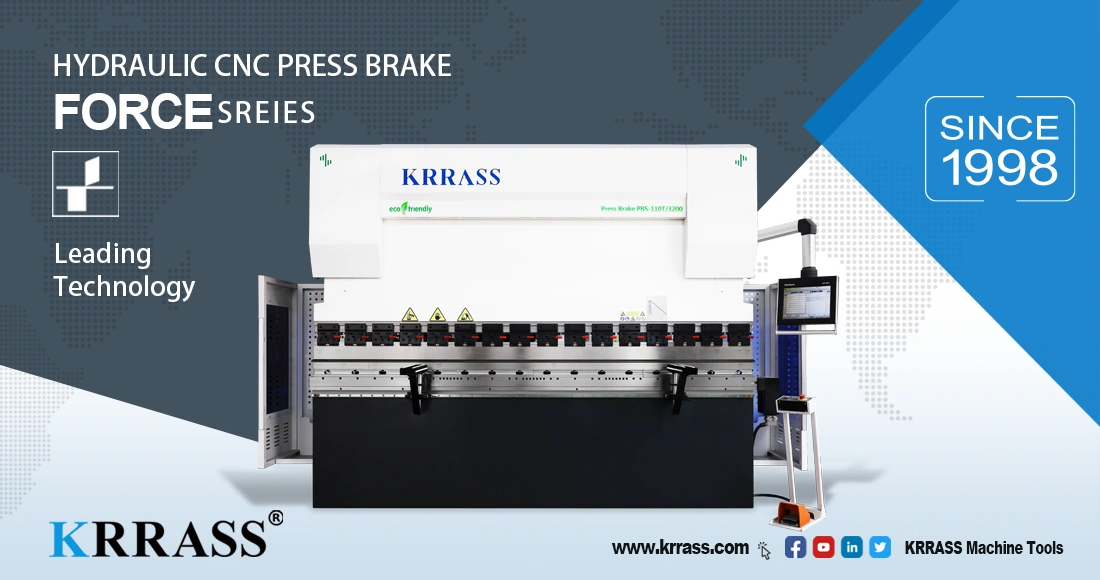Businesses around the world are faced with the choice of which press brake to use every day. It's a tough decision, but it's one you have to make. With so many options on the market, how do you know which press brake is right for you? Thankfully, we're here to help. This blog post will break down the different types of press brakes and help you decide which is right for your business in 2025.
What is a press brake, and what can it do?
Press brakes generally use a CNC system and are equipped with a die (universal or special tooling) to bend the cold sheet metal into various geometric cross-sectional shapes of the workpiece.
Press brake axes have been developed from a single axis to 12 axes, which the CNC system can automatically realize: change in the running height of the slider; change in the left and right tilt of the slider; change in the front and rear of the rear stop and change to the left and right; change in the tonnage of the pressure and change in the speed of the slider, etc.
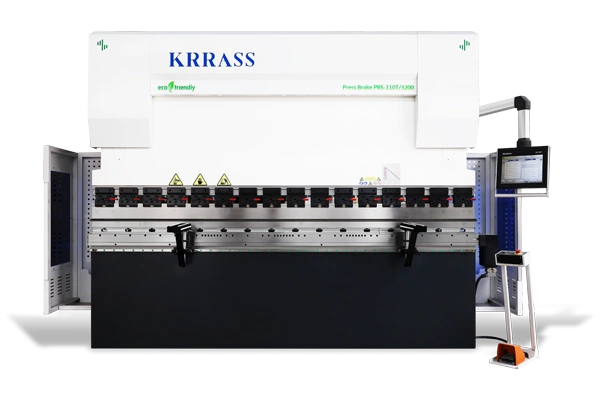
These functions can make the bending machine convenient to achieve: sliding down, pointing, continuous, pressure, return and stop in the middle of the constant action, feeding to complete the same angle or different angles of many elbow bending.
What are the main types of press brakes?
There are three main types of press brakes: manual, hydraulic, and pneumatic. Here's a quick breakdown of each:
Manual Press Brakes:
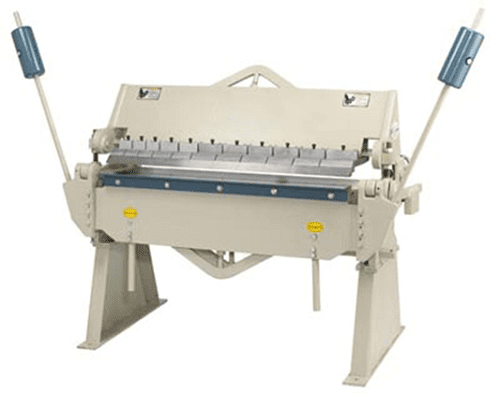
Manual press brakes are operated by hand. They are usually smaller and less expensive than hydraulic or pneumatic pressure brakes.
However, they are also less precise and can be more dangerous to operate on.
If you are interested in manual press brakes, we recommend that you consult a professional before making your sale.
Hydraulic Press Brakes:

Hydraulic press brakes are operated by hydraulic fluid. They are more expensive than manual press brakes but also more precise and can handle larger projects.
If you are considering hydraulic pressure brakes, be sure to factor the cost of hydraulic fluid into your budget.
Most modern hydraulic bending machine systems come with a built-in energy-saving time and pump mechanism, which allows hydraulic bending machines to save energy and withstand high power very well.
Industries that use bending machines for large sheet metal operations that require more than 250 metric tons of bending pressure will often require significant energy. In such cases, hydraulic presses are usually a better choice for them.
Pneumatic Press Brakes:
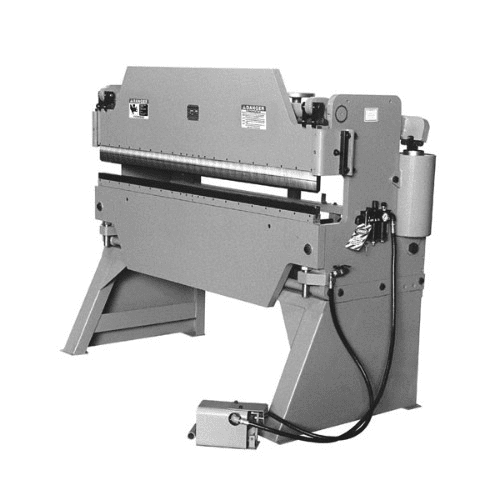
Pneumatic pressure brakes are operated by compressed air. They are usually smaller and lighter than hydraulic brakes, making them easier to move around.
They are also usually less expensive than hydraulic brakes. However, they may need assistance with projects as large or complex as their hydraulic counterparts.
Extended reading: Global Top 10 Press Brake Manufacturers (2025 Updated)
What are the types of brake presses according to the mode of movement?
Up-moving type: This mode of movement is known as "never eliminated", which can bend the workpiece in a wide range and is easy to operate.

Down-moving type: For the limitations caused by the low opening height; it has greatly interfered with the installation of considerable bending or complex workpieces; it is inconvenient to enter and exit the material; the synchronization accuracy is not high; it is difficult to accurately control the depth of the punch into the die; the requirements for workers are high; the die on the workbench runs up with the workpiece, and it is not easy for workers to operate; if workers misoperate, it will easily occur "hit the die", which will easily damage the lower die or the rear material stop finger.
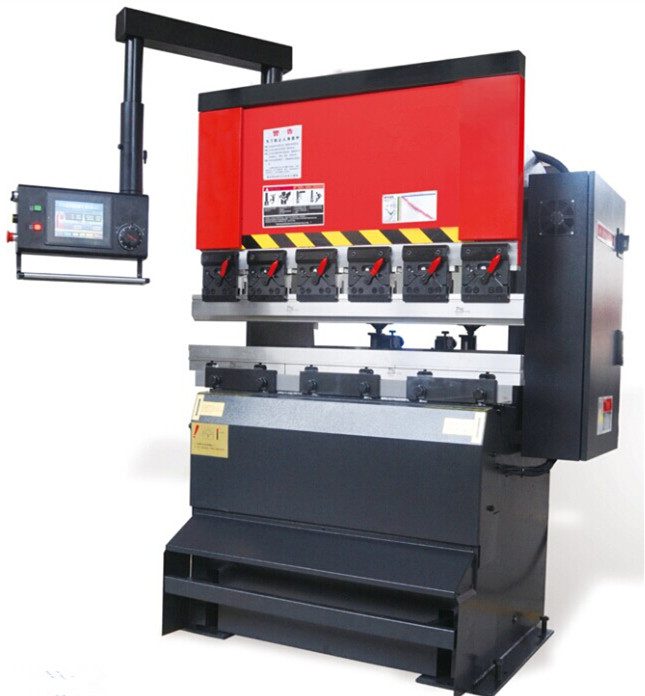
What types of bending machines can be classified according to the synchronization method?
Machine-hydraulic synchronization: products that are already relatively backward and will undoubtedly have less and less demand in the future as time goes by.
Twist axis synchronization: ordinary and semi-automatic CNC products. You can choose standard products such as NC press brake for customers with low requirements.
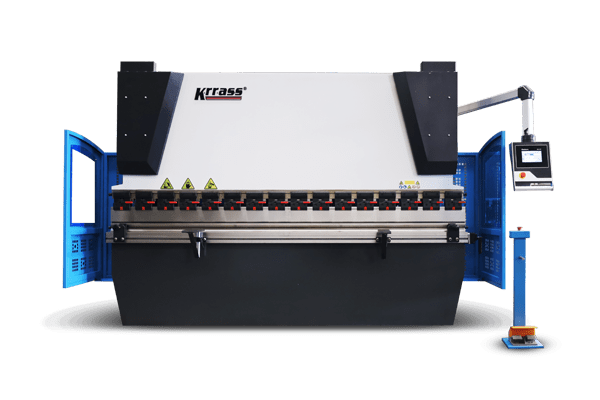
Electro-hydraulic synchronous: fully automatic CNC products, also in recent years, KRRASS machine main products, simple operation, easy to start, suitable for workpiece accuracy, production efficiency and output requirements of high customers, energy saving and environmental protection, standard products such as CNC press brake.

What is the structure of the hydraulic press brake, and what are its characteristics?
Structural composition of the press brake
Hydraulic press brakes are important production machines for bending and forming workpieces in the sheet metal industry. The function of the machine is to bend all kinds of sheet metal materials into parts of various shapes according to the needs of sheet metal materials and processes.
As shown in the figure below, the press brake frame is mainly composed of left and right columns, workbenches, and beams. The left and right oil cylinders are fixed to the column.
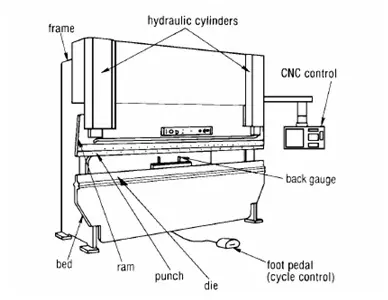
The slider is connected to the piston of the oil cylinder and moves up and down along the guide rail fixed to the column. The lower mold is fixed to the work table. The upper mold is mounted at the lower end of the slider.
The hydraulic system provides power, and the electrical system gives instructions. Under the action of the oil cylinder, the slider drives the upper mold down and the lower mold close to the bending of the sheet metal.
Left and right columns, workbenches, and sliders (hereinafter referred to as the three main parts) are the key parts of the press brake. The total weight of the three main parts accounts for 70% to 80% of the total weight of a press brake.
Its strength and rigidity directly determine the running accuracy of the machine tool, the service life, and the accuracy of the workpiece.
- Slider part: Hydraulic transmission is used, and the slider part is composed of the slider, oil cylinder, and mechanical stop fine-tuning structure. The left and right oil cylinders are fixed to the frame, the piston (rod) drives the slider up and down through hydraulic pressure, and the mechanical stop is controlled and adjusted by the numerical control system.
- Workbench part: It is operated by the button box so that the motor drives the baffle to move back and forth, and the moving distance is controlled by the numerical control system, and the minimum reading is 0.01 mm (the front and rear positions are limited by the travel switch);
- Synchronization system: The hydraulic press brake machine is a mechanical synchronization mechanism composed of a torsional shaft, swing arm, joint bearing, etc., with a simple structure, stable and reliable performance, and high synchronization accuracy. The mechanical stop is adjusted by the motor, and the numerical control system controls the value.
- Material holding mechanism: The material blocking adopts a motor drive, which drives the two screw rods to move synchronously through chain operation, and the numerical control system controls the size of the material blocking.
Structural characteristics of press brakes
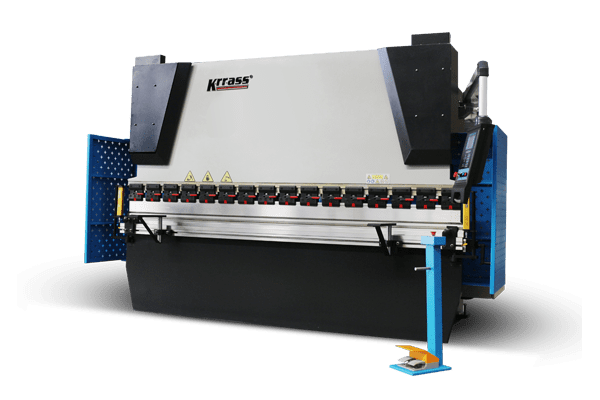
- Adopt all-steel welded structure with sufficient strength and rigidity;
- Hydraulic transmission, the cylinders at both ends of the machine tool are placed on the slider to directly drive the sliding work;
- The slider synchronization mechanism adopts the torsional axis to force synchronization;
- The mechanical block structure is adopted, which is stable and reliable.
- The slider stroke is motorized and quickly adjusted, and manually fine-tuned, and the counter is displayed.
What are the parameters that affect the cnc press brakes?
Before choosing a suitable press brake, you must first understand the type of sheet metal material you want to bend (such as stainless steel, aluminum plate, etc.).
Secondly, you also need to determine the special parameters to consider when calculating the bending of a metal sheet part. These parameters may include:
- Tensile strength
- Thickness and length of metal
- Press brake folding or bending length
- V-shaped groove width
- The inner radius of bending
- Tonnage pressure
Once you have determined the above parameters, you need to calculate the tonnage of pressure required for the bending operation.
The pressure tonnage of the press brake determines the pressure value that the press brake can exert on the sheet metal material during bending operation.
- High tonnage allows bending of thick and hard metals
- Low tonnage is suitable for thin metals.
Note: The wrong tonnage pressure value (too high or too low) is likely to damage your press brake or the metal sheet part you are bending.
What are the bending types of press brake?
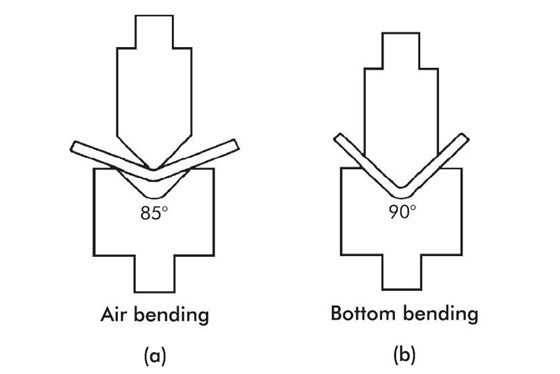
Air bending
In air bending, the end of the upper die and the 2 edges of the V slot of the lower die can complete the sheet metal bending operation.
However, this type of bending will have a rebound effect due to the characteristics of the sheet metal material.
When the tonnage pressure of the bending is weak and the upper die returns, the sheet metal material will bounce up as if it has elasticity.
Therefore, you must adjust the bending angle according to the rebound coefficient of the sheet metal material, and also calculate the margin.
Therefore, for a 90° bending operation, the bending angle must be reduced to 85°.
Other factors that may affect the data should also be considered when calculating this margin, such as: the thickness of the upper die, the bending length, and the width of the V-slot of the lower die, etc.
This type of bending is most commonly used in sheet metal processing because it is suitable for machines with low tonnage pressure, unlike bottom bending that requires more tonnage pressure.
Bottom bending
In bottom bending, the upper die of the press brake bends the sheet metal material with a higher tonnage pressure (3 to 5 times greater than air bending), thereby reducing or preventing the springback effect that often occurs when air is bent.
The process starts in the air bending state and continues down to the bottom of the V slot of the lower die for cold forging. This bending method can provide higher angular accuracy. It is suitable for sheet metal materials with a thickness of more than 2mm.
What should I pay attention to when maintaining and servicing my bending machine?
Before machine tool maintenance or cleaning, the upper mold should be aligned with the lower mold and then lowered and closed until the work is completed. If you need to start up or do other operations, the mode should be selected manually to ensure safety. The maintenance contents are as follows:
1. Hydraulic oil circuit
- Check the fuel tank oil level every week. If the hydraulic system is repaired, it should also be checked. If the oil level is lower than the oil window, hydraulic oil should be added.
- The hydraulic oil used in this machine is ISO HM46 or MOBIL DTE25;
- The oil should be changed after the new machine has worked for 2000 hours, and the oil should be changed after every 4000 to 6000 hours of work in the future, and the oil tank should be cleaned at every oil change;
- The oil temperature of the hydraulic system should be kept between 35°C and 60°C and should not exceed 70°C. If it is too high, it will cause deterioration and damage to the oil and accessories.
2. Filter
- Each time the oil is changed, the filter should be replaced or thoroughly cleaned.
- The machine tool has relevant alarms or other abnormal filters such as unclean oil quality, which should be replaced;
- The air filter on the hydraulic fluid tank should be inspected and cleaned every 3 months, and it is best to replace the air filter directly with a new one for more than a year.
3. Hydraulic components
- Clean hydraulic components (substrates, valves, motors, pumps, YouTube, etc.) every month to prevent dirt from entering the system, and cleaners cannot be used;
- After the new machine has been in use for a month, check to see if there is any deformation in the bending of each YouTube video. If there is any abnormality, it should be replaced. After two months of use, the connections of all accessories should be tightened. When this work is done, the machine should be shut down, and the system has no pressure.
Choose the best Press Brake for your business
Now that you know the different types of press brakes available on the market, it's time to choose the best press brake for your business. To do this, there are three main factors you need to consider: cost, accuracy, and project size.
Cost
As with any major purchase for your business, you need to consider cost when choosing the best press brake.
How much can you afford to spend on a new CNC press brake machine?
How will the cost of maintenance and repairs affect your budget?
And don't forget to factor in the cost of any necessary accessories or accessories—such as dies or jigs—that you'll need to purchase separately.
Precision
Another important factor to consider is the accuracy of the press brakes. Depending on your project requirements, you may need a machine that offers high levels of accuracy and repeatability.
If that's the case, then you'll need to factor precision into your decision-making process.
Project Size
Finally, you need to consider the project size when choosing the best press brake. What types of projects will you use it for?
Will it handle small parts or large sheets?
How thick will the material be?
Answering these questions will help you narrow down your options and choose the right press brake for your needs.
Conclusion
Choosing the best press brake is an important decision for any business owner or operator in 2025. With so many options on the market for press brakes, it can be difficult to know which machine is right for your needs.
However, by taking into account factors such as cost, precision, and project size, you can narrow down your options and choose the perfect machine for your business. Thanks for reading !
KRRASS: The Best Choice For All Sheet Metal Manufacturer
When considering the overall costs of purchasing, maintaining, and operating a sheet metal equipment setup, a sheet metal fabrication service: a press brake machine, is the best option. KRRASS has a tremendous reputation in the market due to its focus on consistency and quality at the most competitive price.
Whether it's press brake or any other application, our team of experts has the right combination of industry knowledge and the latest tool to provide you with the best products and services on the market. Moreover, we set ourselves apart with our advanced system that is completely online. Just let us know what your product needs, request a quote, and start the process.
Make a request and Get Started Today
Get Instant Quote
Learn more about our products, please visit and subscribe to our Youtube channel
